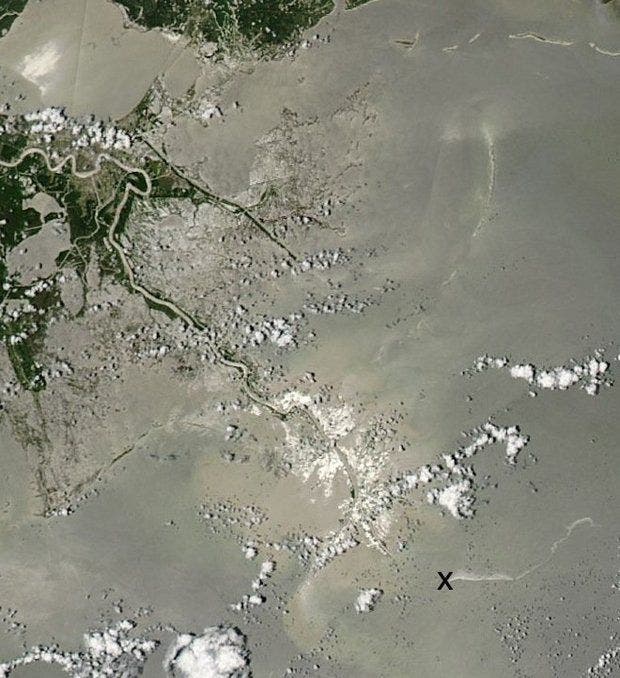It’s one of those things that sounds almost too surreal to be true: for more than a decade, a broken well has been continuously leaking oil into the Gulf of Mexico. According to the Associated Press, Taylor Energy, the an independent American oil company responsible for the spill, agreed to make a $300,000 donation to a Louisiana marine research consortium — to purchase vessels, electronics and other equipment — as well as fund $100,000 worth of research into the ecological effects of long-term oil leaks in the Gulf. The oil spill could continue for a hundred more years, but that’s all they will have to pay for hundreds of thousands of gallons of oil (or millions) spilled into the water.

A 32-mile-long oil slick stretches east from the former site of Taylor Energy’s Mississippi Canyon 20 A platform (X), which was knocked down and covered by a landslide during Hurricane Ivan in 2004. (NASA Aqua satellite)
“We are pleased to have found common ground with Waterkeepers. The agreement balances the public’s right to information with adequate safeguards for Taylor’s proprietary technology,” Will Pecue, Taylor’s president, said in an emailed press statement.
However, according to Waterkeeper Alliance, the matter is still not closed:
“We are very pleased about the progress of negotiations with Taylor, and have come to a conceptual agreement that has not yet been finalized,” Waterkeeper Alliance said in a statement emailed to ThinkProgress. “As no final settlement agreement exists between the parties at this time, we are not at liberty to discuss the details of a potential settlement. We will provide a full statement when the settlement is finalized.”

This March 31, 2015, aerial file photo, shows an oil sheen drifting from the site of the former Taylor Energy oil rig in the Gulf of Mexico, off the coast of Louisiana. Image credits: AP.
It’s not like Taylor Energy did anything themselves to cause the leak – Hurricane Ivan destroyed one of their platforms, causing the leak; the platform was tightly secured to the bottom of the sea, according to existing regulations.
“It was subsequently located lying in an almost horizontal orientation and almost entirely buried in sediment up to 100 feet deep, approximately 900 feet from its original location and in approximately 440 feet of water,” Taylor Energy officials said in papers filed in federal court as part of a lawsuit against the firm’s insurance company.
Also, very day, an airplane with contractors working for Taylor Energy flies over the area looking for oil sheens, and the company has sold all its offshore assets. As of April, they only have one full time employee – charged with managing the spill. But that doesn’t clear them of responsibility at all.
For years, Taylor was not forced to disclose details about its cleanup efforts, nor were they forced to disclose their information on the oil spill; as you might expect, that allowed them to fly some things under the radar. The same AP investigation found massive under-reporting in the volume of the spill, showing that actual amounts were some 20 times higher than figures put forth by Taylor Energy. This means that the gallons of spilled oil aren’t in the hundreds of thousands, but in the millions. They also found that Taylor’s claims that the leak is slowing down weren’t exactly true.
There’s also the fact that the leak will go on for decades (or up to 100 years), and the fact that when you’re buying or building an offshore oil platform, you are taking some risks, so is the $400,000 compensation really enough? I’m not convinced.









